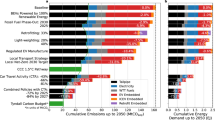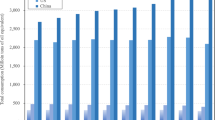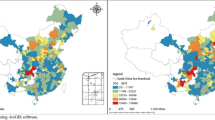Abstract
Carbon emission reduction in the transportation sector is essential in the global mitigation effort, and a large-scale public transport system has the potential to be an effective instrument. High-speed rail (HSR) is one such example, yet it is unclear how much reduction in road traffic results from new rail routes. Using the difference-in-differences method, we show that new HSR routes in China lead to a 20.5 log-point reduction in the number of passenger vehicles and a 15.7 log-point reduction in freight vehicles running on parallel highways. These reductions were not seen on ordinary national roads. These effects translate into an annual reduction of 11.183 million tons of CO2 equivalent of GHG emissions or 1.33% of GHG emissions in China’s transport sector. This mitigation effect mainly comes from the substitution of highway goods transport with the conventional railway instead of the direct replacement of highway passenger transport with HSRs. The environmental benefit of HSR in China has not been fully realized because of the thermal-dominated electricity supply. Our further projections suggest that in greener electricity conditions, the HSR in China can substantially contribute more to the reduction in GHG emissions from the transport sector.
This is a preview of subscription content, access via your institution
Access options
Access Nature and 54 other Nature Portfolio journals
Get Nature+, our best-value online-access subscription
$29.99 / 30 days
cancel any time
Subscribe to this journal
Receive 12 print issues and online access
$209.00 per year
only $17.42 per issue
Buy this article
- Purchase on Springer Link
- Instant access to full article PDF
Prices may be subject to local taxes which are calculated during checkout



Similar content being viewed by others
Data availability
The datasets analysed during the current study are not publicly available due to the confidentiality of the road monitoring data subject to a non-disclosure agreement but are available from the corresponding author on reasonable request.
Code availability
The Stata code used for the analysis of HSR’s effect in this Article is available from https://github.com/MondayX/Code_HSReffect_NCC.git.
Change history
08 December 2021
A Correction to this paper has been published: https://doi.org/10.1038/s41558-021-01253-w
References
CO2 Emissions by Sector, World 1990–2018 (IEA, 2021); https://www.iea.org/data-and-statistics/data-browser/?country=WORLD&fuel=CO2%20emissions&indicator=CO2BySector
Oil Products Final Consumption by Sector, World 1990–2018 (IEA, 2021); https://www.iea.org/data-and-statistics/data-browser/?country=WORLD&fuel=Energy%20consumption&indicator=OilProductsConsBySector
Hayashi, Y., Morichi, S., Oum, T. H. & Rothengatter, W. Intercity Transport and Climate Change: Strategies for Reducing the Carbon Footprint (Springer, 2014).
The Future of Rail: Opportunities for Energy and the Environment (IEA, 2019).
Borsati, M. & Albalate, D. On the modal shift from motorway to high-speed rail: evidence from Italy. Transp. Res. Part A 137, 145–164 (2020).
Duranton, G. & Turner, M. A. The fundamental law of road congestion: evidence from US cities. Am. Econ. Rev. 101, 2616–2652 (2011).
2020 China Railway Yearbook (China State Railway Group Co. Ltd., 2021)
Chen, Y. & Whalley, A. Green infrastructure: the effects of urban rail transit on air quality. Am. Econ. J. Econ. Policy 4, 58–97 (2012).
Lalive, R., Luechinger, S. & Schmutzler, A. Does expanding regional train service reduce air pollution? J. Environ. Econ. Manag. 92, 744–764 (2018).
Bauernschuster, S., Hener, T. & Rainer, H. When labor disputes bring cities to a standstill: the impact of public transit strikes on traffic, accidents, air pollution, and health. Am. Econ. J. Econ. Policy 9, 1–37 (2017).
Guo, X., Sun, W., Yao, S. & Zheng, S. Does high-speed railway reduce air pollution along highways? Evidence from China. Transp. Res. Part D 89, 102607 (2020).
Beaudoin, J. & Lawell, C.-Y. C. L. in Urban Transport Systems (ed. Yaghoubi, H.) Ch. 6 (IntechOpen, 2017).
Rivers, N., Saberian, S. & Schaufele, B. Public transit and air pollution: evidence from Canadian transit strikes. Can. J. Econ.53, 496–525 (2020).
He, H. The revenue of China’s high-speed rail exceeds expectations. Chinanews (7 December 2010); http://www.chinanews.com/cj/2010/12-07/2706603.shtml
CO2 Emissions by Sector, People’s Republic of China 1990–2018 (IEA, 2021); https://www.iea.org/data-and-statistics/data-browser/?country=CHINA&fuel=CO2%20emissions&indicator=CO2BySector
2020 China Energy Statistical Yearbook (Department of Energy Statistics of the National Bureau of Statistics, 2021).
Notice on the Preparation of the ‘The Fourteenth Five-Year Plan’ for Renewable Energy Development (National Energy Administration, 2020); http://zfxxgk.nea.gov.cn/2020-04/09/c_138978661.htm
Ou, X., Xiaoyu, Y. & Zhang, X. Life-cycle energy consumption and greenhouse gas emissions for electricity generation and supply in China. Appl. Energy 88, 289–297 (2011).
Zhou, G., Ou, X. & Zhang, X. Development of electric vehicles use in China: a study from the perspective of life-cycle energy consumption and greenhouse gas emissions. Energy Policy 59, 875–884 (2013).
Chang, Y. et al. The energy use and environmental emissions of high-speed rail transportation in China: a bottom-up modeling. Energy 182, 1193–1201 (2019).
Zhu, P., Lin, Y. & Guo, Y. How Much Does High-speed Rail Substitute for Air Travel? Implications for Transport, Environmental and Energy Policies Working Paper (Research Square, 2020); https://doi.org/10.21203/rs.3.rs-106949/v1
Electricity Generation by Source, France 2019 (IEA, 2021); https://www.iea.org/data-and-statistics/data-tables?country=FRANCE&energy=Electricity&year=2019
Electricity Generation by Source, Canada 2019 (IEA, 2021); https://www.iea.org/data-and-statistics/data-tables?country=CANADA&energy=Electricity&year=2019
Electricity Generation by Source, Denmark 2019 (IEA, 2021); https://www.iea.org/data-and-statistics/data-tables?country=DENMARK&energy=Electricity&year=2019
Electricity Generation by Source, Spain 2019 (IEA, 2021); https://www.iea.org/data-and-statistics/data-tables?country=SPAIN&energy=Electricity&year=2019
Electricity Generation by Source, Japan 2019 (IEA, 2021); https://www.iea.org/data-and-statistics/data-tables?country=JAPAN&energy=Electricity&year=2019
Electricity Generation by Source, Germany 2019 (IEA, 2021); https://www.iea.org/data-and-statistics/data-tables?country=GERMANY&energy=Electricity&year=2019
Report of Nutrition and Chronic Diseases of Chinese Residents (The National Health Commission of the People’s Republic of China, 2015); http://www.nhc.gov.cn/jkj/s5879/201506/4505528e65f3460fb88685081ff158a2.shtml
2017 Yearbook of China Transportation & Communications (China Communications and Transportation Association, 2018).
2017 China Logistics Yearbook (China Federation of Logistics & Purchasing, 2018).
Cai, H. & Xie, S. Determination of emission factors from motor vehicles under different emission standards in China. Acta Sci. Nat. Univ. Pekin. 46, 319–326 (2010).
Song, R., Yang, S. & Sun, M. GHG Protocol Tool for Energy Consumption in China v2.1 (World Resources Institute, 2013).
Acknowledgements
We highly appreciate L. Zhu and L. Shao for their work cleaning raw data. We are also grateful for the funding by the National Natural Science Foundation of China (projects 71874093 and 91546113) received by J.W.
Author information
Authors and Affiliations
Contributions
All authors equally contributed to the Article. Y.L., Y.Q. and J.W. conceptualized the study and carried out initial planning. M.X. constructed the dataset and carried out the statistical analysis under the guidance of Y.L., Y.Q. and J.W. All four authors contributed to the writing of the manuscript.
Corresponding author
Ethics declarations
Competing interests
The authors declare no competing interests.
Additional information
Peer review information Nature Climate Change thanks the anonymous reviewers for their contribution to the peer review of this work.
Publisher’s note Springer Nature remains neutral with regard to jurisdictional claims in published maps and institutional affiliations.
Supplementary information
Supplementary Information
Supplementary Note, Figs. 1–3, Tables 1–22 and Refs. 1–24.
Rights and permissions
About this article
Cite this article
Lin, Y., Qin, Y., Wu, J. et al. Impact of high-speed rail on road traffic and greenhouse gas emissions. Nat. Clim. Chang. 11, 952–957 (2021). https://doi.org/10.1038/s41558-021-01190-8
Received:
Accepted:
Published:
Issue Date:
DOI: https://doi.org/10.1038/s41558-021-01190-8
This article is cited by
-
Impact of battery electric vehicle usage on air quality in three Chinese first-tier cities
Scientific Reports (2024)
-
Can the opening of high-speed rail reduce environmental pollution? An empirical research based on difference-in-differences model
Clean Technologies and Environmental Policy (2024)
-
Sky views
Nature Climate Change (2023)
-
Development patterns, material metabolism, and greenhouse gas emissions of high-speed railway in China
Communications Earth & Environment (2023)
-
Future reductions of China’s transport emissions impacted by changing driving behaviour
Nature Sustainability (2023)



